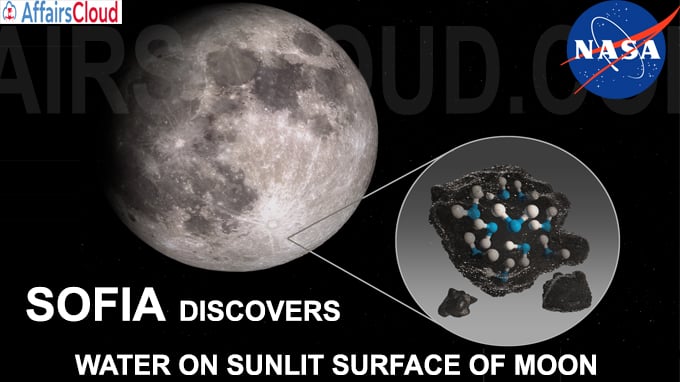 On October 27, 2020, For the first time, National Aeronautics and Space Administration’s (NASA) Stratospheric Observatory for Infrared Astronomy (SOFIA) has confirmed water on the sunlit surface of the Moon. SOFIA has detected water molecules (H2O) in Clavius Crater, one of the largest craters visible from Earth, located in the Moon’s southern hemisphere. The results are published in the latest issue of Nature Astronomy.
On October 27, 2020, For the first time, National Aeronautics and Space Administration’s (NASA) Stratospheric Observatory for Infrared Astronomy (SOFIA) has confirmed water on the sunlit surface of the Moon. SOFIA has detected water molecules (H2O) in Clavius Crater, one of the largest craters visible from Earth, located in the Moon’s southern hemisphere. The results are published in the latest issue of Nature Astronomy.
- This discovery indicates that water may be distributed across the lunar surface, and not limited to cold, shadowed places.
- SOFIA, a modified Boeing 747SP jetliner used its 106-inch Faint Object infraRed CAmera for the SOFIA Telescope (FORCAST) to pick up the specific wavelength unique to water molecules, at 6.1 microns, and discovered a surprising concentration of 100 to 412 parts per million – roughly equivalent to a 12-ounce bottle of water , trapped in a cubic meter of soil spread across the lunar surface.
Point to be noted:
–This discovery is a part of NASA’s Artemis program, under which NASA tries to learn about the presence of water on the Moon in advance of sending the first woman and next man to the lunar surface in 2024 and establishing a sustainable human presence there by the end of the decade.
–Previous research has found indications of water by scanning the surface but was unable to distinguish between water (H2O) and hydroxyl, a molecule made up of one hydrogen atom and one oxygen atom. But this new discovery provides further chemical proof that the Moon holds molecular water, even in sunlit areas.
Recent Related News:
i.On 2nd September 2020, New research paper titled “Widespread hematite at high latitudes of the Moon” published on Science Advances reviewed the data from the Moon Mineralogy Mapper Instrument(M3) of Chandrayan-1 orbiter of Indian Space Research Organisation (ISRO) and found the Hematite (iron oxide or rust) at the high latitudes of the moon.
ii.On 14th September 2020, a team of scientists announced the discovery of Phosphine, a rare molecule which provides a possibility of microbial life in the clouds of the Venus.
Professor Jane Greaves, Cardiff University, United Kingdom was the lead author of a report published in Nature Astronomy.
About National Aeronautics and Space Administration’s (NASA):
Administrator– James Frederick Bridenstin
Headquarters– Washington, D.C., United States (US)




